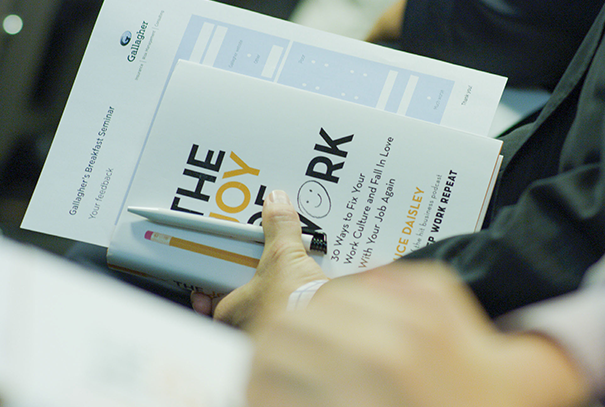
In our recent breakfast seminar, our guest speaker Bruce Daisley, EMEA Vice President of Twitter and best-selling author of The Joy of Work, took us on a whistlestop tour of a world of research and his own personal experience and insights to offer his top tips on how to learn to love work again: the key to greater job satisfaction and greater commitment to the organisation.
Bruce Daisley believes work culture is in a predicament and there’s no easy solution. During his seven years at Twitter, he found that as the company grew, the highly motivated approach of many of the staff diminished. This wasn’t something isolated to Twitter either. He learnt that across the globe, only around a quarter to a fifth of all workers were engaged. In a bid to find out why, Bruce started a podcast called Eat Sleep Work Repeat where he invited experts - psychologists and academics - to discuss issues related to work culture.
Silicon Valley companies often claim to have a great work culture. But having worked in that environment, Bruce doesn’t think they have all the answers. Take technology entrepreneur and billionaire Elon Musk as an example. The co-founder of PayPal – just one of his many business ventures - famously stated that: “Nobody ever changed the world on 40 hours a week”.
He works 120 hours a week, sleeps under his desk in a sleeping bag around three times a week and believes that unless you’re working 80 hours a week, you’re barely showing up. This is incredibly dangerous for young people to hear, adds Bruce.
In 2014, economist John Pencavel looked at how many hours the optimum working week might contain. He found that the output of physical labour declines after 55 hours. If this is true about physical labour, is it also the case with mental labour? asks Bruce.
In 2014, economist John Pencavel looked at how many hours the optimum working week might contain. He found that the output of physical labour declines after 55 hours. If this is true about physical labour, is it also the case with mental labour? asks Bruce.
Learning to love work again
Overload represents the biggest challenge facing all of us, says Bruce. According to Harvard Business Review, the average executive or manager – spends 23 hours a week in meetings. The average office worker spends closer to 16 hours. That’s between 2 – 3 days a week in meetings.
When we try to make progress at work, it’s the emails and meetings that get in way, he says. We need to find a way to get these things out of our team’s way when we are trying to improve engagement.
So, assuming distractions are limited, how can we learn to love work again? Bruce highlights a couple of obvious ones: sleep more and get happier friends! The former is obviously more controllable than the latter.
On top of these, he outlines five key ways to help us love work:
1. Understand how we think
Our best ideas don’t come to us when we’re sat staring at a screen, hand on our mouse. Hollywood screenwriter Aaron Sorkin gets his best ideas in the shower, which is why he has 8 - 10 showers a day and installed one in his office. Our brain’s daydreaming ‘default’ mode is when most of our creative thinking happens.
2. Understand how we team
All the evidence suggests that humans derive joy from being in synchrony with those around us. When we feel connected to others, it’s transformative and energising. Think how you feel when you’re dancing with others, singing in a choir or celebrating sporting success. It can lead to better work too. For example, in 1920, Harvard psychologist Floyd Allport observed that the simple fact of working alongside someone – even if they’re working independently – increases productivity: the slower worker speeding up to be in sync with the faster worker.
3. Understand how we relax
The power of a shared break. Research on call centre workers found that those who went on a 15-minute shared break were 19% less stressed and had a 23% performance increase. The human connection that takes place in the workplace is a massive contribution to enjoying work.
4. Understand how we belong
One of the trends over recent years is the growth of workplace loneliness. A survey last year by Relate suggested that 42% of British workers say they don’t have a friend at work. Meanwhile, a study by Professor Julianne Holt-Lunstad found that isolation increases the risk of a person’s premature death by 50%, whereas obesity increases it by just 30% in comparison. In short, ‘belongingness’ is a human need, says Bruce. At work, a feeling of belonging among the people with whom we spend five days a week is essential to workplace happiness. This brings obvious considerations for all employers, but especially where remote workers and contractors are concerned.
Understanding all of the above and encouraging humanity in the workplace – or, as Professor of Management Sigal Barsade describes it ‘companionate love’ – will help both employees and the bottom line. Barsade’s own research (involving 3,200 employees across seven different industrial sectors) suggests that ‘companionate love’ is accompanied by greater job satisfaction, greater commitment to the organisation and also greater accountability.
To find out more read the full event summary
Sources:
- Replacing an employee costs £30,000 report says, Acas website [Accessed October 2019].
- The evidence: Case study heroes and engagement data demons, Engage for Success, 2016.

